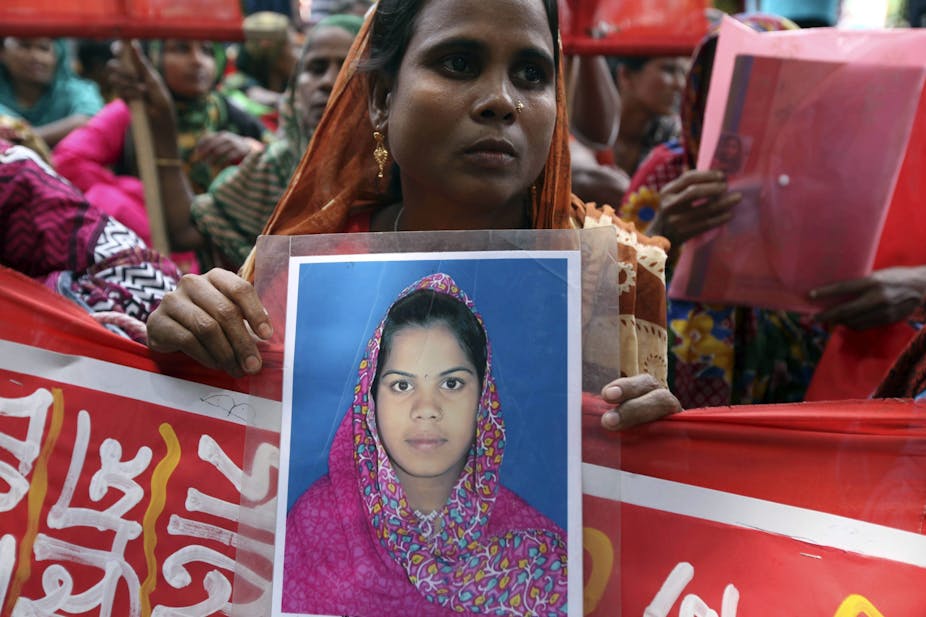In the days after the tragic collapse of the Rana Plaza factory complex in the Dhaka suburb of Savar, the story made headlines across the world’s media. As the death toll climbed rapidly from initial reports of several hundred to reach a formal 1127, becoming the world’s worst ever factory accident, the story continued to make news.
In Europe and North America, the weeks after the collapse saw strong consumer backlash against big brands that were identified as buying ready-made garments (RMGs) from Rana Plaza and similar factories. Pressure from the public, NGOs and governments led to the launch of the Accord on Fire and Building Safety in Bangladesh.
Whilst some European brands signed up immediately, there was a somewhat slower response from Australian retailers. However, led by Kmart and Target, the Accord was signed in due course by a few more, including Cotton On and Forever New. But, other major brands such as Big W and Rivers remain notably absent from the list of signatories.
In the two months after the collapse, as the Accord remained newsworthy, some elements of the Australian media continued to show some interest. In late June, The Age reported both on the controversy surrounding Australian retailers involvement in low-cost production in Bangladesh and also on the continuing hardship facing survivors. Both the ABC and SBS must be commended for their attention to events beyond the immediate collapse.
Now, however, nearly five months on from the collapse, there is no real mainstream media interest in the story. The official death toll now stands at 1133 but there are still several hundred unaccounted for. Organizations like Oxfam continue to advocate for more signatories to the Accord, but this is one of many campaigns to which they must subscribe and it is no longer the headline story.
Yet, despite the absence of media interest, the greatest tragedy of the Rana Plaza collapse is only now unfolding. The continuing hardship that The Age reported in June, as above, is becoming a situation of dire poverty and destitution for many. The Bangladesh Daily Star this month highlights this “ongoing tragedy”, providing a stark account of lives that have been destroyed yet the victims must go on living as best they can.

The vast majority of the workers in Rana Plaza were women and many of those that survived the collapse now face very uncertain futures. Young women who were severely injured, many losing limbs, are now without work, have received little if any financial compensation and have no social security safety net. Worse, there are many who, as the previous family breadwinners, are now seen as worthless burdens on their families.
Using pseudonyms because of the fear under which they live, two women named as Fatema and Farida tell of lives before the accident. In abusive marital relationships they were lied to, cheated and ultimately abandoned. To support themselves, they went to work in Rana Plaza. Both survived the collapse, suffering serious injury. Now, their lives are even worse than before.
They have received small sums from the prime minister’s fund and food aid from foreign companies that bought goods from Rana Plaza. However, both are now unemployed, almost destitute and living in fear for the future. They can afford neither food nor medical expenses. Their tales appear typical of women who have suffered crippling injury and then been abandoned or thrown out by husbands and families who see no further use for them, only burdens that they do not wish to carry.
A number of sources commented in the aftermath of Rana Plaza that it was but the most recent and most severe of many such incidents. There have been numerous factory collapses and fires in Bangladesh in recent years. In November 2012, fire in a RMG factory in Dhaka killed 117 workers. Weeks after Rana Plaza, fire in another factory killed eight. These are indicative of a continuing problem, despite Rana Plaza being presented in much of the media as a singular event.
I propose that we in Australia must look at these and other events in a new light. We must move away from thinking of a tragic building collapse on 24 April that killed a certain number. We must see Rana Plaza as an ongoing and unfolding tragedy that continues to cause death and misery, and will do so for the foreseeable future. We must see it as just the most serious of a continuous stream of such tragedies. Also, we must see it as a tragedy in which most of us are implicated, as we continue to benefit from the RMG industry of Bangladesh.
However, as informed commentators pointed out, we must not simply stop buying from Bangladesh. We must continue to support the livelihoods of those women who remain in work and on whom so much of the population depend for income and support. We must advocate for and be actively engaged in promoting real change for the benefit of the workers – the women and their dependents.
Perhaps we should also look at ourselves in the mirror and question why it is that we measure the scale of any tragedy – whether building collapse, fire, earthquake or flood – not in terms of its ongoing impact on the living, but in terms of the number of deaths condensed into the “main event”.

